+ Open data
Open data
- Basic information
Basic information
| Entry | Database: PDB / ID: 6h55 | ||||||
|---|---|---|---|---|---|---|---|
| Title | core of the human pyruvate dehydrogenase (E2) | ||||||
 Components Components | Dihydrolipoyllysine-residue acetyltransferase component of pyruvate dehydrogenase complex, mitochondrial Dihydrolipoyl transacetylase Dihydrolipoyl transacetylase | ||||||
 Keywords Keywords |  OXIDOREDUCTASE / OXIDOREDUCTASE /  Pyruvate dehydrogenase / Pyruvate dehydrogenase /  human human | ||||||
| Function / homology |  Function and homology information Function and homology information dihydrolipoyllysine-residue acetyltransferase / dihydrolipoyllysine-residue acetyltransferase /  dihydrolipoyllysine-residue acetyltransferase activity / acetyl-CoA biosynthetic process from pyruvate / dihydrolipoyllysine-residue acetyltransferase activity / acetyl-CoA biosynthetic process from pyruvate /  pyruvate dehydrogenase complex / pyruvate dehydrogenase complex /  : / : /  Pyruvate metabolism / Glyoxylate metabolism and glycine degradation / Regulation of pyruvate dehydrogenase (PDH) complex / Signaling by Retinoic Acid / Pyruvate metabolism / Glyoxylate metabolism and glycine degradation / Regulation of pyruvate dehydrogenase (PDH) complex / Signaling by Retinoic Acid /  tricarboxylic acid cycle ... tricarboxylic acid cycle ... dihydrolipoyllysine-residue acetyltransferase / dihydrolipoyllysine-residue acetyltransferase /  dihydrolipoyllysine-residue acetyltransferase activity / acetyl-CoA biosynthetic process from pyruvate / dihydrolipoyllysine-residue acetyltransferase activity / acetyl-CoA biosynthetic process from pyruvate /  pyruvate dehydrogenase complex / pyruvate dehydrogenase complex /  : / : /  Pyruvate metabolism / Glyoxylate metabolism and glycine degradation / Regulation of pyruvate dehydrogenase (PDH) complex / Signaling by Retinoic Acid / Pyruvate metabolism / Glyoxylate metabolism and glycine degradation / Regulation of pyruvate dehydrogenase (PDH) complex / Signaling by Retinoic Acid /  tricarboxylic acid cycle / glucose metabolic process / tricarboxylic acid cycle / glucose metabolic process /  mitochondrial matrix / intracellular membrane-bounded organelle / mitochondrial matrix / intracellular membrane-bounded organelle /  mitochondrion / identical protein binding mitochondrion / identical protein bindingSimilarity search - Function | ||||||
| Biological species |   Homo sapiens (human) Homo sapiens (human) | ||||||
| Method |  ELECTRON MICROSCOPY / ELECTRON MICROSCOPY /  single particle reconstruction / single particle reconstruction /  cryo EM / Resolution: 6 Å cryo EM / Resolution: 6 Å | ||||||
 Authors Authors | Haselbach, D. / Prajapati, S. / Tittmann, K. / Stark, H. | ||||||
| Funding support |  Germany, 1items Germany, 1items
| ||||||
 Citation Citation |  Journal: Structure / Year: 2019 Journal: Structure / Year: 2019Title: Structural and Functional Analyses of the Human PDH Complex Suggest a "Division-of-Labor" Mechanism by Local E1 and E3 Clusters. Authors: Sabin Prajapati / David Haselbach / Sabine Wittig / Mulchand S Patel / Ashwin Chari / Carla Schmidt / Holger Stark / Kai Tittmann /   Abstract: The pseudo-atomic structural model of human pyruvate dehydrogenase complex (PDHc) core composed of full-length E2 and E3BP components, calculated from our cryoelectron microscopy-derived density maps ...The pseudo-atomic structural model of human pyruvate dehydrogenase complex (PDHc) core composed of full-length E2 and E3BP components, calculated from our cryoelectron microscopy-derived density maps at 6-Å resolution, is similar to those of prokaryotic E2 structures. The spatial organization of human PDHc components as evidenced by negative-staining electron microscopy and native mass spectrometry is not homogeneous, and entails the unanticipated formation of local clusters of E1:E2 and E3BP:E3 complexes. Such uneven, clustered organization translates into specific duties for E1-E2 clusters (oxidative decarboxylation and acetyl transfer) and E3BP-E3 clusters (regeneration of reduced lipoamide) corresponding to half-reactions of the PDHc catalytic cycle. The addition of substrate coenzyme A modulates the conformational landscape of PDHc, in particular of the lipoyl domains, extending the postulated multiple random coupling mechanism. The conformational and associated chemical landscapes of PDHc are thus not determined entirely stochastically, but are restrained and channeled through an asymmetric architecture and further modulated by substrate binding. | ||||||
| History |
|
- Structure visualization
Structure visualization
| Movie |
 Movie viewer Movie viewer |
|---|---|
| Structure viewer | Molecule:  Molmil Molmil Jmol/JSmol Jmol/JSmol |
- Downloads & links
Downloads & links
- Download
Download
| PDBx/mmCIF format |  6h55.cif.gz 6h55.cif.gz | 50.3 KB | Display |  PDBx/mmCIF format PDBx/mmCIF format |
|---|---|---|---|---|
| PDB format |  pdb6h55.ent.gz pdb6h55.ent.gz | 27.8 KB | Display |  PDB format PDB format |
| PDBx/mmJSON format |  6h55.json.gz 6h55.json.gz | Tree view |  PDBx/mmJSON format PDBx/mmJSON format | |
| Others |  Other downloads Other downloads |
-Validation report
| Arichive directory |  https://data.pdbj.org/pub/pdb/validation_reports/h5/6h55 https://data.pdbj.org/pub/pdb/validation_reports/h5/6h55 ftp://data.pdbj.org/pub/pdb/validation_reports/h5/6h55 ftp://data.pdbj.org/pub/pdb/validation_reports/h5/6h55 | HTTPS FTP |
|---|
-Related structure data
| Related structure data |  0138MC  6h60C M: map data used to model this data C: citing same article ( |
|---|---|
| Similar structure data |
- Links
Links
- Assembly
Assembly
| Deposited unit | 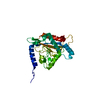
|
|---|---|
| 1 | x 60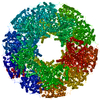
|
- Components
Components
| #1: Protein |  Dihydrolipoyl transacetylase / 70 kDa mitochondrial autoantigen of primary biliary cirrhosis / PBC / Dihydrolipoamide ...70 kDa mitochondrial autoantigen of primary biliary cirrhosis / PBC / Dihydrolipoamide acetyltransferase component of pyruvate dehydrogenase complex / M2 antigen complex 70 kDa subunit / Pyruvate dehydrogenase complex component E2 / PDCE2 Dihydrolipoyl transacetylase / 70 kDa mitochondrial autoantigen of primary biliary cirrhosis / PBC / Dihydrolipoamide ...70 kDa mitochondrial autoantigen of primary biliary cirrhosis / PBC / Dihydrolipoamide acetyltransferase component of pyruvate dehydrogenase complex / M2 antigen complex 70 kDa subunit / Pyruvate dehydrogenase complex component E2 / PDCE2Mass: 69069.398 Da / Num. of mol.: 1 Source method: isolated from a genetically manipulated source Source: (gene. exp.)   Homo sapiens (human) / Gene: DLAT, DLTA / Production host: Homo sapiens (human) / Gene: DLAT, DLTA / Production host:   Escherichia coli (E. coli) Escherichia coli (E. coli)References: UniProt: P10515,  dihydrolipoyllysine-residue acetyltransferase dihydrolipoyllysine-residue acetyltransferase |
|---|
-Experimental details
-Experiment
| Experiment | Method:  ELECTRON MICROSCOPY ELECTRON MICROSCOPY |
|---|---|
| EM experiment | Aggregation state: PARTICLE / 3D reconstruction method:  single particle reconstruction single particle reconstruction |
- Sample preparation
Sample preparation
| Component | Name: single particle cryo EM-derived map of the full-length native human E2-E3BP core of the pyruvate dehydrogenase multienzyme complex Type: COMPLEX / Entity ID: all / Source: RECOMBINANT |
|---|---|
| Source (natural) | Organism:   Homo sapiens (human) Homo sapiens (human) |
| Source (recombinant) | Organism:   Escherichia coli (E. coli) Escherichia coli (E. coli) |
| Buffer solution | pH: 8 |
| Specimen | Embedding applied: NO / Shadowing applied: NO / Staining applied : NO / Vitrification applied : NO / Vitrification applied : YES : YES |
| Specimen support | Grid type: Quantifoil R3.5/1 |
Vitrification | Cryogen name: ETHANE |
- Electron microscopy imaging
Electron microscopy imaging
| Experimental equipment |  Model: Titan Krios / Image courtesy: FEI Company |
|---|---|
| Microscopy | Model: FEI TITAN KRIOS |
| Electron gun | Electron source : :  FIELD EMISSION GUN / Accelerating voltage: 300 kV / Illumination mode: SPOT SCAN FIELD EMISSION GUN / Accelerating voltage: 300 kV / Illumination mode: SPOT SCAN |
| Electron lens | Mode: BRIGHT FIELD Bright-field microscopy / Cs Bright-field microscopy / Cs : 0.01 mm : 0.01 mm |
| Image recording | Average exposure time: 1 sec. / Electron dose: 41 e/Å2 / Detector mode: INTEGRATING / Film or detector model: FEI FALCON II (4k x 4k) / Num. of grids imaged: 1 / Num. of real images: 2250 |
| EM imaging optics | Spherical aberration corrector : Microscope was modified with a Cs corrector with two hexapole elements : Microscope was modified with a Cs corrector with two hexapole elements |
| Image scans | Movie frames/image: 1 |
- Processing
Processing
CTF correction | Type: PHASE FLIPPING AND AMPLITUDE CORRECTION |
|---|---|
| Symmetry | Point symmetry : I (icosahedral : I (icosahedral ) ) |
3D reconstruction | Resolution: 6 Å / Resolution method: FSC 0.143 CUT-OFF / Num. of particles: 29788 / Algorithm: FOURIER SPACE / Symmetry type: POINT |
 Movie
Movie Controller
Controller



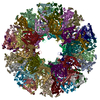

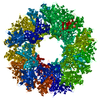


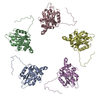

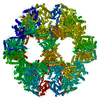

 PDBj
PDBj


